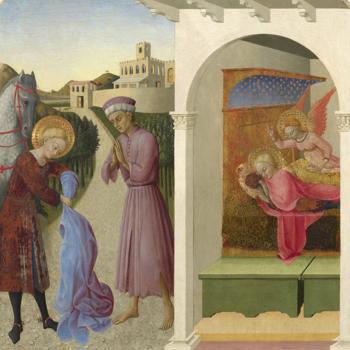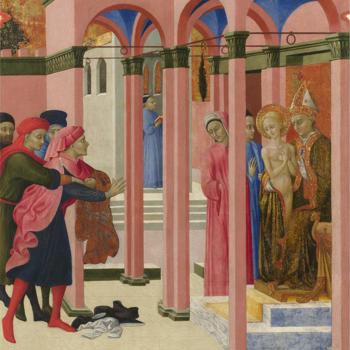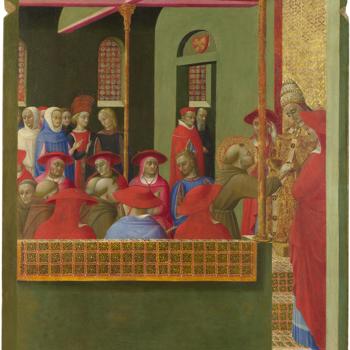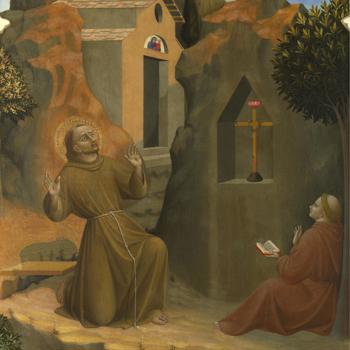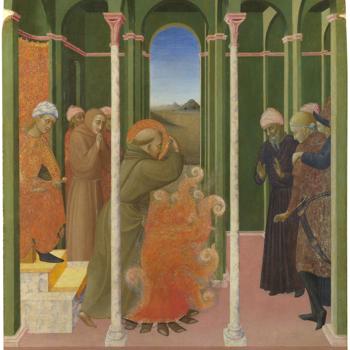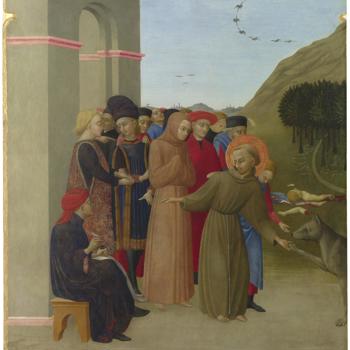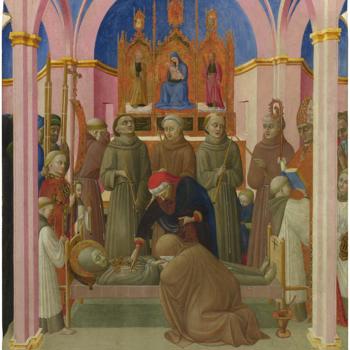Sassetta, The Funeral of Saint Francis
San Sepolcro Altarpiece
These paintings were once part of one of the largest and most splendid altarpieces of the early Italian Renaissance. Made up of almost 60 panels, the double-sided altarpiece was painted for the high altar of San Francesco in Borgo San Sepolcro, a town near Arezzo. The back, which was seen primarily by the friars, showed Saint Francis in glory surrounded by eight scenes of his life, seven of which are in the National Gallery’s collection.
Unusually, surviving documents tell us a lot about how it was commissioned, constructed and paid for. The project was begun in 1426 but had foundered, and in September 1437 Sassetta took over. In early 1439 two friars visited him in Siena, bringing the scripta, a document stating what he was to depict. Although they provided the text, the artist provided the imagination: the scripta states that the friars, themselves artisans, and the painter together should decide on the details.
These paintings of episodes from the life of Saint Francis of Assisi come from the back of one of the largest and most splendid altarpieces of the early Italian Renaissance. Made up of almost 60 panels and measuring 6 m high by 5 m wide, this double-sided polyptych was painted for the high altar of San Francesco in Borgo San Sepolcro, a town near Arezzo.
Double-sided altarpieces were a particular feature of Franciscan churches in Umbria, where the friars sat in stalls behind the altarpiece. Taddeo di Bartolo had made a similar construction for San Francesco al Prato in Perugia in 1403, and several decades before one was painted for a church in the neighbouring town of Città di Castello. Unusually, surviving documents tell us a lot about how the San Sepolcro altarpiece was commissioned, constructed and paid for. In 1426 the operai (the group that oversaw the works and furnishing of the church) contracted a carpenter to carve a double-sided altarpiece. The young Piero della Francesca began working on it in 1432, but it was abandoned and a new start was made. In September 1437, Sassetta took over the project.
Two copies of the 1437 contract survive (one for the artist, one for the friars). In it Sassetta agreed make an identical wooden altarpiece and to paint it with stories chosen by the friars, using the finest pigments and the best of his skill and ingenuity, within four years. Rather than work at San Francesco, Sassetta chose to remain in Siena: he was to transport the completed sections to Borgo San Sepolcro and assemble them there. For this he was to be paid the enormous sum of 510 florins (the cost of about five respectable middle-class houses at that time).
The first installment was paid in February 1438. Nearly a year later two friars visited Sassetta, bringing the scripta, a document stating what he was to depict. Although they provided the text, the artist provided the imagination: the scripta states that the friars, themselves artisans, and the painter together should decide on the details. In general, they followed the narratives of Francis' official biography, Saint Bonaventure’s Legenda Maior, so closely that it’s tempting to think of them all studying the texts together.
On the front of the altarpiece, facing the nave, were the Virgin and Child with angels (Louvre, Paris), flanked by Saint John the Baptist and the Blessed Ranieri Rasini (Berenson Collection, Villa I Tatti, Settignano) on the left, and Saint John the Evangelist and Saint Anthony of Padua on the right (Louvre, Paris). The predella showed scenes of the Passion of Christ; other saints decorated the pinnacles. The back, seen primarily by the friars, showed Saint Francis in glory surrounded by eight scenes of his life, seven of which are in the National Gallery’s collection. The back-facing predella showed episodes from the life of Ranieri Rasini, a local holy man who was buried beneath the altar.
The altarpiece was installed on 2 June 1444, seven years after it was commissioned. We know from a nineteenth-century drawing that it was inscribed with the name of the artist and the date, and also the names of the two operai responsible, Christopher and Andrew. The eponymous saints for those involved in the commission appeared in the piers and pinnacles.
The altarpiece was dismantled during the Counter-Reformation in the late sixteenth century, and its panels dispersed after the monastery’s suppression in 1808–10 (28 survive in collections across the world).

